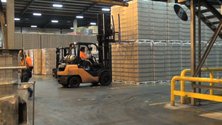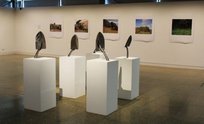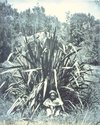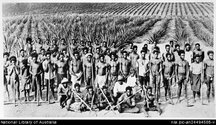Scott Hamilton – 3 February, 2015
Expensive Movements was broadcast on two large and silent screens mounted alongside one another. The left hand screen carried footage shot in a hotel somewhere in Auckland; the scenes shown on the right hand screen were recorded in the large brewery that stands beside the Great South Road near Otahuhu.
Pukekohe
Group exhibition
Making Visible
Curated by Ioana Gordon-Smith,
8 November 2014 - 17 January 2015
Late last year Brett Phibbs, a photographer who works for the New Zealand Herald, visited an onion farm near Pukekohe. The Herald published the images that Phibbs took at the farm in a two-page spread, under the headline ‘Brings tears to your eyes’. (1)
Most of the Herald‘s spread was devoted to a photograph that showed a middle-aged woman bent over a bulging brown sack. Scores of other sacks stood in rows around the woman. The woman’s posture and oversized, rumpled sweater and jeans made her resemble one of the sacks she had just filled with onions. It was as though she were waiting, like the onions, to be picked up and removed from the farm.
The caption to Phibbs’ photograph explained that the sacks belonged to ‘Pukekohe-based growers the Balle Bros’, and that they were being ‘left to cure for a couple of days in the field’ before being packed and despatched to buyers. The caption made no mention of the stooped woman at the centre of Phibbs’ photograph.
Phibbs’ photographs reminded me of some of some of the images of indentured Pacific Island labourers on nineteenth century plantations. I thought about a photograph that Daniel Mundy took in 1871, during a visit to a Hokianga estate where a gang of indentured ni-Vanuatu were picking and milling flax. Mundy showed one of the men seated on the ground, in front of a massive flax plant whose tendrils seemed about to entangle him. In a photograph taken by an unknown artist somewhere in Queensland in the 1890s, indentured Melanesian workers were arranged in the same straight rows as the thousands of pineapple plants that stretched away behind them. Human beings had become flora. (2)
Since 2008, many of the men and women who bring in the harvests on New Zealand farms have been participants in the Recognised Seasonal Employment scheme. The RSE brings eight thousand Pacific Islanders into New Zealand every year to work for the minimum wage, and sometimes for less than the minimum wage, on farms and orchards and in vineyards.
The men and women brought to New Zealand under the RSE scheme are bonded to their employers; if they leave their jobs, they must leave the country. Many of them spend months in New Zealand, year after year, but their time here does not entitle them to permanent residency, let alone citizenship. The contracts they sign with employers and with the New Zealand state oblige them to take out private health insurance, because they are not entitled to free care in our public hospitals and clinics. Their bank accounts and leisure activities are closely monitored; a drinking session or unauthorised road trip can sometimes earn a ticket home.
At the end of the Masters thesis she wrote about a group of ni-Vanuatu recruited to pick grapes in the South Island, Rochelle-Lee Bailey argued that the RSE scheme could only meet its goals by keeping the workers it brought to New Zealand ‘unfree’. Employers had interest, she suggested, in regarding their RSE guests as labour machines, rather than as human beings with agency. (3)
A couple of days after the photographs Brett Phibbs took at the Balle Brothers’ farm appeared in the New Zealand Herald, I visited Making Visible, an exhibition curated by Ioana Gordon-Smith for the New Zealand Steel Gallery in Franklin Arts Centre in Pukekohe. In a statement distributed at the gallery, Gordon-Smith explained that her exhibition reflected ‘a strong sympathy for migrant and Pacific workers’ whose ‘labour often goes unacknowledged’ in New Zealand.
Making Visible included photographs of Lonnie Hutchinson’s 1988 performance work Can you see me?, during which she protested the invisibility of Pacific Islanders by wrapping herself in brown packing tape and lying in Auckland’s Aotea Square.
Gordon-Smith had juxtaposed the writhing Hutchinson with some of the ‘urban taros’ - cone-shaped lumps of plaster loaded into crates, as though they were ripe vegetables, or mortar shells, or some other saleable commodity - that John Vea showed off a year ago at the Papakura Art Gallery, and with a series of polished shovel blades that Toa Tahi Taihia entitled Buried at Sea. Vea’s ‘taros’ and Taihia’s blades refer to the millions of hours of manual labour that Pacific Islanders have done for New Zealand employers and for the New Zealand army, in the trenches of building sites and battlegrounds and market gardens. (4)
A series of photographs by Talia Smith showed marginal, scruffy spaces - neither urban nor rural, neither occupied nor completely abandoned - which might have been metaphors for the place of migrant labourers in the consciousness of most New Zealanders. Making Visible also included a mysterious installation by Janet Lilo, and a video work by Salome Tanuvasa called Expensive Movements.
When I talked with a guide at the New Zealand Steel Gallery, she reported that many visitors to Making Visible had enjoyed the show, but that some of them had walked away as soon as they recognised what the artists were saying. Workers from the Pacific Islands were not, these visitors apparently believed, proper subjects for art.
I am not surprised that Making Visible made some Pukekoheans uneasy. For more than a century, the volcanic soil that surrounds the town has been attracting migrant labour. Gujaratis, Punjabi Sikhs, Chinese, and Maori from the Taranaki and upper Waikato have all planted and harvested crops like potatoes, onions, and courgettes. Today, thanks to the RSE scheme, the gardens of the Pukekohe district fill regularly with workers from the Pacific Islands. I-Kiribati pick tomatoes in glasshouses; Tongans harvest potatoes and onions.
But Pukekohe does not have a history of making members of cultural minorities welcome. In the 1920s the town was the headquarters of the White New Zealand League, which warned of the dangers of immigration, and demanded the deportation of ‘Hindoos’ and ‘Celestials’; in the ‘50s its segregated pubs and movie theatre earned it the nickname ‘the Little Rock of New Zealand’; and in recent years it has been home to the Franklin E Local, a giveaway newspaper known for its claims that white people, rather than Maori, were the first settlers of New Zealand, and for its defence of Allan Titford, an anti-Maori activist serving a long jail term for rape and arson. (5)
When she put together a show celebrating migrant labour for Pukekohe’s art gallery, Ioana Gordon-Smith was waving a red rag at an old and ugly bull.
Salome Tanuvasa’s Expensive Movements was made in 2012 and has been exhibited several times since. Tanuvasa grew up in the East Auckland suburb of Panmure, inside a migrant family with relatives in Samoa and Tonga. During a lecture she gave during the Southside Arts Festival in 2012, the artist remembered spending hours hanging around factories, while her parents finished long shifts. Tanuvasa described her parents’ toil in language that was once realistic and defiantly poetic:
The working class is what I know. Most of my family have only worked in labour-intensive jobs. This place [I visited] in Panmure reminded me of my mother’s old job. The sound of small motors running, the radio playing, and a pile of fabric forming its own sculpture on the factory floor. (6)
Expensive Movements was broadcast on two large and silent screens mounted alongside one another. The left hand screen carried footage shot in a hotel somewhere in Auckland; the scenes shown on the right hand screen were recorded in the large brewery that stands beside the Great South Road near Otahuhu. (The liquor factory is owned by Dominion Breweries, the company that markets tipples like Tui and DB Bitter. In 2005, Dominion Breweries marked its seventy-fifth birthday by offering every adult New Zealander a free beer; a few days later one hundred and seventy brewery workers, including some of the staff at Otahuhu, walked off the job, complaining that the company’s generosity did not extend to their wages.)
As a female worker in a beige blue uniform moved about a hotel room, stripping sheets from a double bed with a practiced haste, a series of men and a woman wearing orange and dark blue overalls climbed aboard small forklifts to stack crates of beer, or else peered at the brown, unlabelled bottles that trembled endlessly through the brewery on a conveyor belt. A curtain blocked the hotel room’s window, so that the cleaner worked by the amber light of a bedside lamp. The brewery, which appeared to lack windows altogether, was filled with the same colour, thanks to lights embedded in its walls.
Tanuvasa’s camera watched the cleaner discreetly, through the door of her room. The brewery workers, too, were often viewed from a distance. The silence of both videos made the movements of the workers seem curiously solemn.
The cleaner eventually stepped into a narrow hall, where she loaded bedsheets onto a trolley and stripped the lining from a rubbish bin, and then visited a room dominated by an ironing machine. She and a male colleague fed towels to the monster.
In the brewery forklifts continued to move to and fro, as crates were shifted and stacked, and sometimes, it seemed, shifted and stacked again. (I was unsure what all the shifting and stacking was intended to achieve. Could the different stacks might be explained by differences in the flavour, or destination, of the brewery’s beers? Were the workers separating Tui from DB Bitter, for the convenience of a waiting truck, or were they sorting beer due for delivery to local pubs from stuff bound for the Waikato or Wellington?) A younger and older worker chatted silently over the door of a parked forklift, then returned to their mysterious tasks.
On the left-hand screen, the cleaner had finished her shift at the ironing machine, and returned to a bedroom. As she began to strip a double bed, I realised I was watching a looped film, and that the woman’s labours would never end. The men and woman in the brewery, too, were trapped in a work-loop. They would continue shifting and stacking their crates with the terrible patience of Sisyphus.
As I watched Tanuvasa’s heroes strip the same bed and shift the same crates for the third or fourth time, I realised that my feet had begun to ache. When I watch movies at home, I like to sprawl decadently on a sofa, and to skip backwards and forwards through the action, avoiding scenes I find tiresome and revisiting details that please me. Many of the makers of video and film installations offer their audiences sofas or chairs - when Brett Graham and Lisa Reihana showed the marvellous mixture of film and sculpture they called Aniwaniwa at the Waikato Art gallery a few years ago, they went one better, and laid out mattresses on the floor - and a few offer remote controls. Tanuvasa, though, made me stand through Expensive Movements, and gave me no way to manipulate the flow of her videos. I had to experience events in the same order and at the same pace as the men and women in the brewery and hotel.
Expensive Movements made me think about the films Darcy Lange made in the worksites of northern England and New Zealand in the 1970s and ‘80s. In her talk at the Southside festival, Tanuvasa explained that she wanted to bring people who ‘wouldn’t normally affiliate with art’ into her work. The same desire made Lange take his camera into a Bradford foundry, a Birmingham school, and a pine plantation in Te Ika a Maui. Like Expensive Movements, Lange’s films are unforced, sometimes languid affairs. But where Lange’s films often show a worker or workers performing some specific, readily understood task - explaining a mathematical equation, or felling a tree - the heroes and heroines of Expensive Movements work ceaselessly on jobs whose purpose is not always comprehensible. They seem lost inside processes that extend far beyond the sites where they labour. Tanuvasa makes us lose ourselves with them.
It is tempting to explain the differences between Lange and Tanuvasa’s visions of work by contrasting the world of the 1970s with that of the twenty-first century. Whether he was filming in England or in New Zealand, Lange was moving in the midst of an overwhelmingly unionised, politically powerful working class. Workers could bring down governments as well as companies by walking off the job, and an intricate culture, involving everything from football clubs to political study groups, prospered inside the larger unions. Otahuhu, where Tanuvasa made one of her videos, was dubbed ‘the working class university of New Zealand’, because of the intensity of political education and discussion inside its huge railway workshops and the nearby freezing works. Some of the country’s best intellectuals, like Hone Tuwhare and RAK Mason, were ‘graduates’ of Otahuhu.
Today, in the aftermath of the deindustrialisation and globalisation of so many Western economies in the late twentieth century, unions are smaller, and the sort of consciousness they created is rarer. The language of organised labour, with its clear dichotomous categories - bosses and workers, profits and wages, solidarity and betrayal - is no longer widely understood.
Without the old vocabulary and the view of the world it represented, many workers find twenty-first century capitalism overwhelming and bewildering: a process without any obvious structure or goal. And as capitalism has become more global, it has become more baffling. An apparently uncomplicated device, like a bicycle or a refrigerator, can be manufactured in one country and assembled in another; a phone call to a local business company might be answered at a helpdesk on the other side of the world.
I was pleased to encounter Expensive Movements, because it seemed to me like an implicit reply to the photographs that Brett Phibbs took at the Balle Brothers’ onion farm. Where Phibbs and his captioner made the workers on that farm as unremarkable as onions, Tanuvasa demanded that I not only acknowledge but in some precarious and temporary sense share the labours of the men and women in her videos.
Scott Hamilton
(1) ‘Brings tears to your eyes’ appeared on pages 28 and 29 of the New Zealand Herald on December the 18th. Phibbs’ photos were not placed online, and when contacted the Herald offered EyeContact permission to reproduce them for a fee.
(2) Copies of Mundy’s images are held in several New Zealand museums. The image used here was taken from the online catalogue of the Auckland War Memorial Museum.
(3) Rochelle-lee Bailey’s thesis can be read online at http://ir.canterbury.ac.nz/bitstream/10092/2957/1/thesis_fulltext.pdf. Jonkoping University student Lina Erikson’s study of RSE workers who travelled from ni-Vanuatu to the Bay of Plenty, and complained of their employers’ bullying and duplicity, reinforces some of Bailey’s points. Erikson’s thesis can be read at: http://www.diva-portal.org/smash/get/diva2:225182/FULLTEXT01.pdf
(4) I reviewed John Vea’s show at Papakura Art Gallery for EyeContact: http://eyecontactsite.com/2014/01/planting-plaster-john-vea-and-the-art-of-migrant-l
(5) Jacqueline Leckie’s essay ‘In Defence of Race and Empire: the White New Zealand League at Pukekohe’ was published in the New Zealand Journal of History thirty years ago, and is available online at: http://www.nzjh.auckland.ac.nz/docs/1985/NZJH_19_2_01.pdf
In an article for the Indian Weekender in 2013, Bharat Jamnadas discussed some of the prejudice non-white migrants experienced in Pukekohe during the twentieth century: http://www.indianweekender.co.nz/Pages/ArticleDetails/52/3722/Editorials/Our-Pioneers-did-not-have-it-so-easy The Franklin E Local’s campaign in support of Titford and against the notion of Maori indigenity were the subject of a report by Maori Television’s Native Affairs programme last May: http://www.maoritelevision.com/news/national/native-affairs-tall-tales
(6) Tanuvasa’s lecture can be viewed at http://vimeo.com/55919631
Recent Comments
Richard Taylor
Good review. Just the thing for Pukekohe. It is good conceptual-political art. Good to see some people made uncomfortable by ...








 Two Rooms presents a program of residencies and projects
Two Rooms presents a program of residencies and projects Advertising in this column
Advertising in this column



This Discussion has 1 comment.
Comment
Richard Taylor, 7:48 p.m. 5 February, 2015 #
Good review. Just the thing for Pukekohe. It is good conceptual-political art.
Good to see some people made uncomfortable by seeing what the working class people do. Many, but not all are Maori, Polynesian or immigrants of some kind.
Many are being used and underpaid etc and it may violate UN laws.
Participate
Register to Participate.
Sign in
Sign in to an existing account.